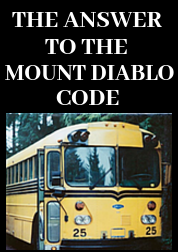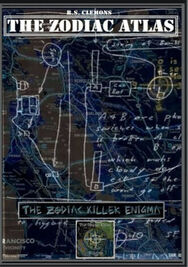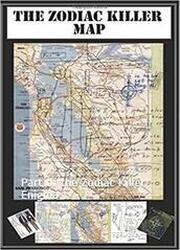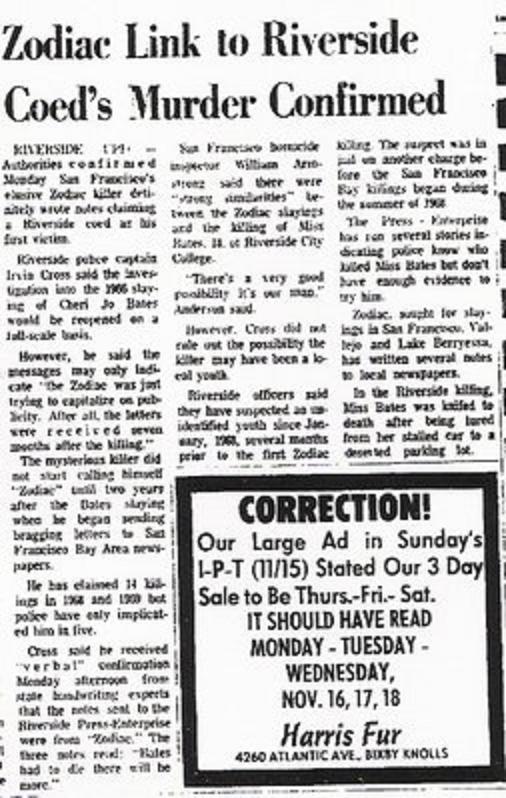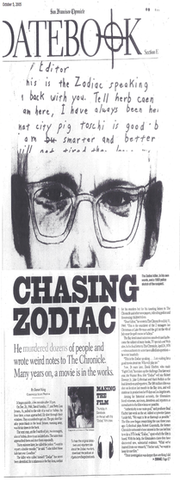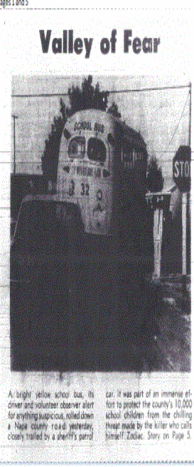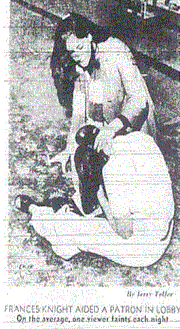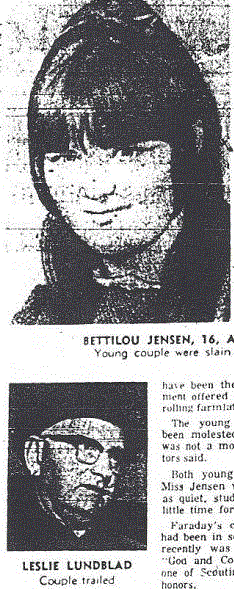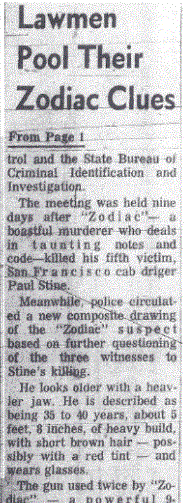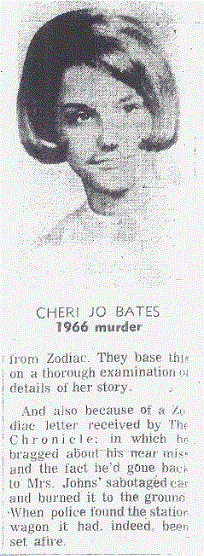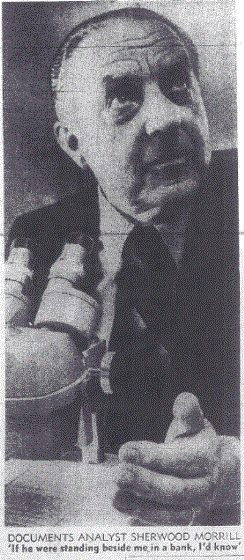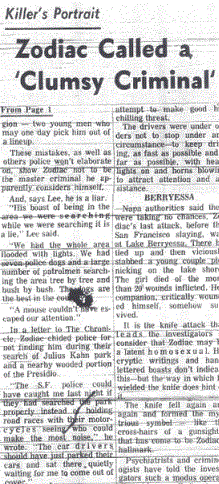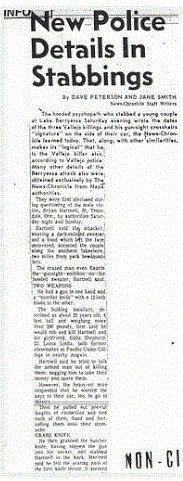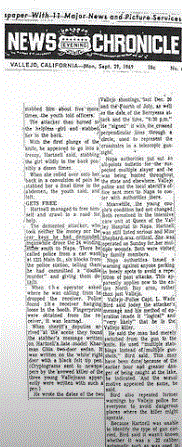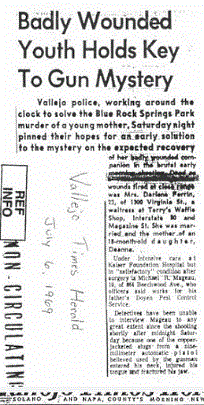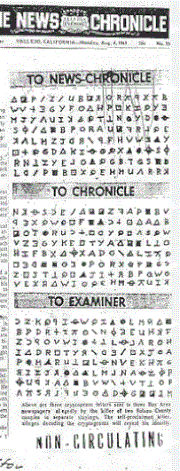 1966 Plymouth Valiant
1966 Plymouth Valiant At Lake Herman Road, what strikes you, are the occupants of two vehicles observed in the run-up to the murder of David Faraday and Betty Lou Jensen. These occupants, despite the publicity these murders generated, never came forward. This may be a fear of implication in the crime, nevertheless, the owner of the white Chevrolet Impala, spotted parked unoccupied in the Lake Herman Road turnout by three witnesses and the blue Valiant observed by William Crow, who stated he was pursued by two Caucasian males in this vehicle within 90 minutes of the double murder, have all remained unidentified. One has to ask, why is the empty Chevrolet Impala sitting parked in the turnout for an extended period of time bearing in mind it was late evening, extremely cold and pitch black? What were the occupant/s of the vehicle doing that night, considering they were never observed in the vicinity at any time by Robert Connelly, Frank Gasser or Bingo Wesner?
The 'Blue Valiant' story by William Crow is difficult to dismiss as irrelevant, having occurred so close to the crime scene - and on the face of it appeared threatening. William Crow would later change the recollection of his encounter that night, in addition to altering his vehicle description to a white Chevrolet. This can be easily interpreted as witness embellishment. Mike Rodelli attempted to contact William Crow in subsequent years to no avail. He addressed William Crow thus; "Since that time, you have become a practicing attorney and are reportedly employed by the local government in Solano County. In February of 2004, you spoke to Zodiac researcher Howard Davis. At this time you had a much different story to tell. You clarified the reason you had pulled over to the side of the road near the pumping station as being to learn how to use "toggle switches" on the dashboard of your girlfriend's car. The chase is now much more detail-filled and very dramatic. The car tried to gain on you and, in trying to get inside your left rear quarter panel, presumably tried to force you off the road. He flashed his lights on and off. In taking the turnoff to Benicia, you apparently had to execute a high speed "evasive" maneuver which the less agile, older car could not handle. There was just one person in the car now and his description was eerily like that which was promoted for the Zodiac killer (i.e., short hair and glasses) after October 1969. The car was now remarkably the "white Chevy" that two other sets of eyewitnesses described that night. You stated that your girlfriend lived in (and presumably purchased her sports car in) San Francisco (or was it Napa?). After the encounter, your common sense kicked in and you went home".
It is not unusual for eyewitnesses to become creative in later accounts, which drives at the heart of their credibility, similar in fashion to the changing stories of Donald Fouke at Presidio Heights. This is what William Crow originally stated; "He was driving his girlfriend's sports car and he was testing it out and adjusting the motor. He was parked in the open area by the pump station and he observed a blue car, possibly a Valiant coming down the road from Benicia towards Vallejo. They passed his location, stopped in the middle of the road and he saw the white lights of the reverse come on and the car started backing up towards them. Mr Owen put the car in gear and took off at a high rate of speed and the car followed him at a high rate of speed. They did not attempt to gain on him, but when they got to the turn off towards Benicia, William Crow turned towards Benicia and the other car went straight ahead. The subjects were both Caucasians and there is no further identification on the car or the subjects".
The level of threat these individuals posed is indeterminable, although they never presented themselves to investigators to clarify their account of proceedings - so the question will still persist - to what extent they were connected to the subsequent murders that night. The significance of the white Chevrolet Impala is equally unclear.
 Lake Herman Road turnout
Lake Herman Road turnout How difficult is it to control two frightened teenagers in near perfect darkness using just a 'pencil flashlight', bearing in mind his vehicle was supposedly parked alongside the victims Rambler, providing limited auxiliary lighting from the headlights of his car. The most obvious position to place his vehicle was to the right and slightly behind, to not only blind his victims and box them in, but to provide some extra illumination in the comission of the crime. The Zodiac also stated "All I had to do was spray them as if it was a water hose; there was no need to use the gun sights". The fact he never used the gunsights may suggest this very scenario. His statement of "all I had to do was spray them" is open to scrutiny, because he never sprayed both victims - David Faraday was shot point blank to the left side of his head. This brings us to the ballistics evidence, covered extensively in regards to two shooters, in the article http://www.zodiacciphers.com/zodiac-news/lake-herman-road-the-ballistics-report
In short, eight bullets were recovered from the crime scene and only one failed to exhibit 'right hand groove class characteristics' - the one retrieved from David Faraday's head at autopsy. Ten casings were detailed in the crime scene sketches, but only nine were sent to the Department of Justice for testing. Since nine of the casings were retrieved from the turnout floor, it seems likely the tenth casing, marked as sitting on the front passenger side Rambler floor, got towed away with the vehicle and separated from the rest of the casings. Therefore, it is possible this casing was never tested. If this tenth casing had exhibited different characteristics to the other nine, then a plausible link could be attributed to this casing and the 'odd man out' bullet. It makes perfect sense, because a head shot into David Faraday from his left side by a right-handed shooter would eject the casing to the right and rear, in direct line with the open passenger door where it was ultimately found. The same could be said of a left-handed shooter securing David Faraday from behind. But without ever locating this missing casing we will never know.
Mike Rodelli responded to this with some additional information, which if correct defies belief: "That missing casing is interesting. I remember being at Russ' home for several days in 2003 and he told me that he had one of the shell casings from LHR. We looked through several ashtrays of junk trying to find it but never did. I wonder if the one he had is the missing one, since the car would have been placed in possession of the SO after the shooting, as seen in several videos. Maybe he took it as a souvenir.". If this were the case, then it is highly unlikely that this promising lead will go anywhere, but it certainly does not discount the possibility that a second gun and second shooter may have been involved that night. Were the two Caucasians spotted by William Crow still en scene, and what role, if any, did the white Chevrolet Impala play?
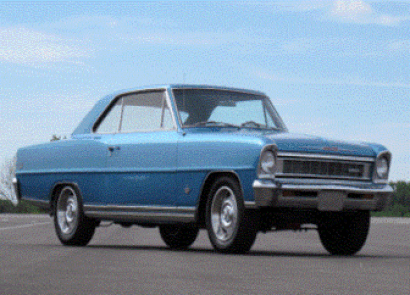 Chevrolet Nova 1966
Chevrolet Nova 1966 On the left is a blue 1966 Chevrolet Nova, which when compared to the 1966 Plymouth Valiant above has a similar square looking design. In addition, the Chevrolet Nova II and Chevrolet Nova II 327 exhibit equally similar features and specifications. These vehicles have been selected for a reason.
The three women at Lake Berryessa, who spotted a suspicious man in the run up to the double stabbing of Bryan Hartnell and Cecelia Shepard on September 27th 1969, described his vehicle as a late model, 1966/7 Chevrolet, light or sky blue in color, with long rear taillights rather than round. These Chevrolet Nova models have long taillights. Not a great match up admittedly, however, the police took tire impressions of a vehicle they suspected parked by Bryan Hartnell's Karmann Ghia on the day of the crime, that may have been the killer's vehicle. The mystery man spotted by the three women may not have been the Zodiac Killer, but the tire tracks or tread impression widths of a Chevrolet Nova, if he drove such a vehicle, are almost identical to the track width of the observed tire impressions by police.

Track width is a measurement from tire center to tire center.
If you look at the specs of a 1959 or 1960 Chevrolet Impala, the tire width is 205 mm or 8.07 inches. This would mean that the center of the tire is situated at roughly 4 inches. It would be nice to think, that if we added the 4 inches of both tires to the 52 inches in the police report (measured to the inside of the tread above), we would get 60 inches track width, which happens to be the exact front width shown here of the 1960 Chevrolet Impala (although 59.3 in the rear). However, tire width and tread width are not the same (shown in the photograph above), where the rubber cambers off on the edge of the tire, meaning the tread width is often smaller than tire width. This is often different bearing in mind the aspect ratio of a tire, given as 75% on a 1960 Chevrolet Impala, in respect to rim size. Here is a brief explanation on Youtube. If we take the median value of the tread impression widths (5 1/2 inches and 4 1/2 inches) stated in the police report above, we have an approximation of 5 inches tread width. This can vary front and back.

The three girls descriptions, suggested a 1966 or 1967, late model blue Chevrolet, 2-door, with one highlighting long taillights. The question being, could this description be enough to provide a match to the tire impressions found close to Bryan Hartnell's vehicle. We are looking for a Chevrolet somewhere in the range of 57 inch wheel track width. Here are examples of the Chevrolet II Nova, beginning with the 2-door '66 model.
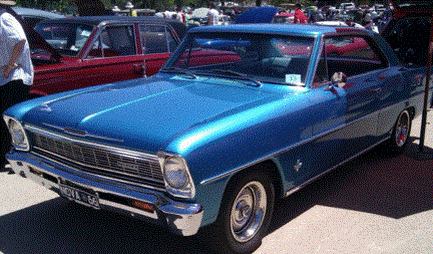 Chevrolet II Nova 1966
Chevrolet II Nova 1966 If we take the median value of the tire impressions from the police report, then as already stated, we have a track width of 57 inches. If we take the low end estimate of the tire impressions of approximately 4 1/2 inches, this gives a track width of 56.50 inches. Here are the complete specs of the Chevrolet Nova II from two sources. Here and here.
The track width for the front is 56.80 inches, very close to the 57.00 inches estimated from the police report. The track width for the rear is 56.30 inches, very close to 'the suspect track nearer the fence, measured at approximately 4 1/2 inches in width.' This was the closest fit I could find, matching as many specifications as possible, including the color, make, year, taillights, door and track width, and combining both scenes at Lake Berryessa - but this of course is the best one can manage without comprehensive identification. Had William Crow identified a blue Chevrolet Nova instead of a blue Valiant, then its significance may have ramped up a notch. He may have been mistaken on December 20th 1968, after all, he apparently only saw its front and rear end in near pitch darkness. He would eventually change his statement in 2004 to a white Chevrolet - so by taking half of each statement - we could manufacture our blue Chevrolet like magic.
Seven months after Lake Herman Road, the killer struck for a second time, attacking Michael Mageau and Darlene Ferrin at Blue Rock Springs Park. Again, two vehicles may have come into play. Michael Mageau described a vehicle pulling alongside Darlene Ferrin's brown Corvair before leaving in the direction of Springs Road. Approximately five minutes later, this vehicle, or a different vehicle, pulled up about ten feet to their rear. The occupant exited his vehicle with torch and gun in hand, approached the couple's vehicle and fired five shots at the defenseless victims through the open side passenger window. He then retreated, before returning to fire off a further four shots.
 Darlene Ferrin (22)
Darlene Ferrin (22) This attack, and the one at Lake Herman Road, both may have displayed some sort of reconnaissance before the murders ultimately took place, with unidentified vehicles and persons unknown present before each crime.
At Lake Herman Road we had an extensive DOJ ballistics report (although missing one vital casing), along with detailed, if inaccurate police sketches. Blue Rock Springs Park on the other hand, has very little. No extensive ballistics report available to the public and no photographs of the crime scene whatsoever. We know that nine expended bullet casings were retrieved from the crime scene, seven found to the right side of the Corvair and two on the back seat floorboard of the vehicle, as though the killer had leaned into the vehicle to deliver the final two shots at Michael Mageau, who had clambered to the rear of the vehicle to escape the initial barrage. The strange thing about this shooting, is that the killer had unleashed nine shots towards his victims, yet despite both Michael Mageau and Darlene Ferrin being alive after the first five shots, he retreated according to Michael Mageau. Why didn't he just use up the whole magazine, or nine shots in one 'sitting' so to speak? Although not privy to the Blue Rock Springs ballistics report, I suspect the expended casings were compared and shown to have been the product of one firearm - but who fired the nine shots? This may seem a stupid question, but Michael Mageau by his own admission, stated a vehicle pulled up behind them with the headlights on and a man exited with a flashlight. At near midnight with limited alternative lighting, this would have made it extremely difficult to ascertain how many occupants were present in the assailant's vehicle.

Lake Berryessa is totally different. We know that one masked man was responsible for the stabbing of Bryan Hartnell and Cecelia Shepard. What we don't know is who wrote on Bryan Hartnell's car door. We assume it was the same person who committed the stabbing. Lake Berryessa had limited escape routes by car, with the crime being perpetrated during daylight hours and boats still circling the lake. Would our killer be eager to leave the scene of crime as soon as he reached his vehicle? Would he take the time to write on Bryan Hartnell's Karmann Ghia? Or would it have been much easier for a second person to have written on the vehicle while the attack was underway, so as to facilitate a quick exit along Knoxville Road? Again, neither can be proved or disproved.
Finally, we have the Presidio Heights murder of Paul Stine on October 11th 1969. There have been many debates on where the actual murder took place, in light of no gunshot being heard by the three teenagers across the street - or any other resident for that matter. But what we do know, is that we cannot inextricably link the man observed in the taxicab with Paul Stine's shooting. By the time the three teenagers had looked out of their window that night, all they observed was a man in the front seat of the taxicab, presumably tearing off a swatch of Paul Stine's shirt. The shooter (his accomplice) may have already vacated the taxicab before the teenagers came to the window. Nobody knows the time period between the taxicab arriving at Washington and Cherry and the teenagers initial observations. The shooter could have been long gone and the 'clean up' guy was taking care of business. Without the gun, his lack of urgency may have been measurable by his actions.




 RSS Feed
RSS Feed

